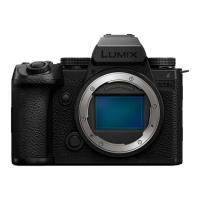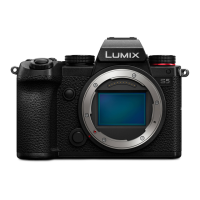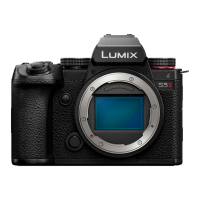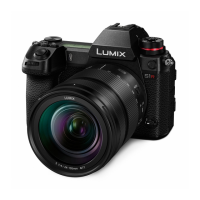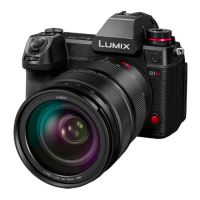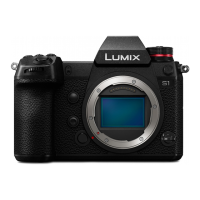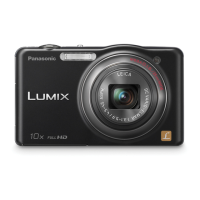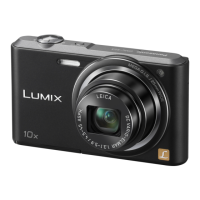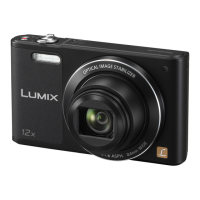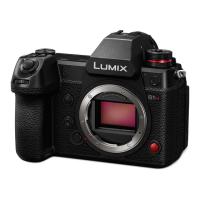Do you have a question about the Panasonic LUMIX S5II and is the answer not in the manual?
Explains the meaning of black and gray icons used to indicate function availability.
Defines symbols used for classifications like confirmations, hints, notifications, and related functions.
Covers firmware updates, handling the camera, splash resistance, and condensation precautions.
Lists the digital camera body and other included accessories such as battery pack, AC adaptor, and cables.
Details compliance with L-Mount standard and compatibility with 35mm full-frame and APS-C lenses.
Describes SD memory cards, SDHC, and SDXC memory cards supported by the camera.
Identifies and explains the various buttons, dials, and connectors on the camera body and supplied lenses.
Provides a step-by-step procedure for attaching the camera's shoulder strap to prevent drops.
Explains how to charge the battery using the camera body or an optional battery charger.
Details the correct procedure for inserting the battery into the camera and securing it.
Outlines the approximate charging time (220 min) using the supplied AC adaptor.
Explains how to charge the camera while using it via USB PD compatibility.
Details how to insert memory cards, supports double card slot function for relay/backup/allocation recording.
Instructs on attaching Leica Camera AG L-Mount standard lenses, emphasizing clean environment and lens cap.
Demonstrates how to adjust the monitor's direction and angle for optimal viewing.
Guides the user through setting the language, time zone, and clock upon initial camera power-on.
Provides instructions on holding the camera with both hands to minimize shake and avoid covering key components.
Explains how to rotate the mode dial to select recording modes like iA, P, A, S, M, Creative Video, S&Q, and Custom.
Identifies and explains the camera's operation parts: front dial, rear dial, control dial, cursor buttons, etc.
Covers settings for the viewfinder, including diopter adjustment, and switching between monitor/viewfinder.
Describes how to quickly set frequently used functions without accessing the main menu.
Explains how to view and change current recording settings directly on the monitor via touch.
Details how to navigate menus using cursors, joystick, dial, or touch, and explains menu item descriptions.
Guides the user on how to enter characters using the on-screen keyboard for various settings.
Explains the iA mode for automatic scene detection and optimal recording settings.
Describes how to use touch functions for AF, shutter, and AE adjustments directly on the screen.
Covers fundamental operations for taking pictures, including selecting recording mode and adjusting focus.
Explains how to select the image aspect ratio from options like 4:3, 3:2, 16:9, 1:1, 65:24, and 2:1.
Details how to set the picture's image size, which varies based on aspect ratio and lens used.
Explains how to set the compression rate for storing pictures (FINE, STD., RAW+FINE, RAW).
Covers fundamental operations for video recording, including selecting mode, starting, stopping, and screen displays.
Explains how to change the system frequency for video recording and playback (NTSC, PAL, CINEMA).
Details the recording file format options for videos: MP4 and MOV.
Sets the image quality for videos based on recording mode, system frequency, and file format.
Allows setting the image area for video recording, affecting angle of view and enabling telescopic effect.
Explains how to select the focusing method (AFS, AFC, MF) to match subject movement.
Details automatic focusing, including AF custom settings, focus limiter, AF assist light, and AF micro adjustment.
Guides on selecting AF modes like Automatic Detection, Tracking, Full Area AF, Zone, 1-Area+, 1-Area, and Pinpoint.
Covers moving, changing size, resetting the AF area, and operations using touch or joystick.
Explains manual focusing, including focus peaking, MF assist screen, and operations during manual focus.
Details how to use optical zoom and extended tele conversion for enhanced telescopic effects.
Explains how to achieve further enlargement beyond optical zoom without image quality deterioration.
Explains how to switch drive modes (Single, Burst, High Resolution, Time Lapse, Stop Motion, Self-timer) to match conditions.
Details how to take continuous pictures and select burst rates (SH, H, M, L) for different recording needs.
Describes merging multiple images for high resolution, suitable for static subjects, with RAW or JPEG output.
Explains automatic picture taking at set intervals for observing changes over time, can be combined into video.
Covers taking pictures while moving subjects for stop motion videos, saved as group images.
Disables all operation sounds and light output, muting audio and setting flash/AF assist light to forced off.
Allows selection of shutter type (AUTO, MECH., EFC, ELEC., ELEC.+NR) for taking pictures.
Details the use of in-body and in-lens image stabilizers, including Dual I.S.2 and 5-Axis Hybrid Image Stabilizer.
Explains different types of optical measurement for brightness: Multi-metering, Center-weighted, Spot, and Highlight-weighted.
Describes automatic setting of shutter speed and aperture, with Program Shift for adjusting combinations.
Allows setting aperture value before recording, with shutter speed set automatically by the camera.
Allows setting shutter speed before recording, with aperture value set automatically by the camera.
Enables manual setting of aperture value and shutter speed, with ISO sensitivity adjustable or automatic.
Explains how to compensate exposure for brightness differences, adjustable in 1/3 EV steps.
Details setting light sensitivity (ISO) from 100 to 51200, supporting Dual Native ISO for high sensitivity.
Explains correcting color cast from light source and adjusting coloring for desired ambiance.
Allows selection of finishing settings (Vivid, Natural, Monochrome, etc.) and applying LUT files.
Enables recording with additional image effects (filters) and adjusting effect for each filter.
Explains how to register LUT files for use with Photo Style and LUT View Assist.
Covers vignetting, color shading, and diffraction compensation to improve image quality.
Details attaching an external flash to the hot shoe and preventing vignetting by removing the lens hood.
Covers setting flash mode (Forced Flash On, Slow Sync, Forced Flash Off), firing mode, and flash adjustments.
Explains how to use optional flashes for wireless flash recording and control firing of multiple flash groups.
Describes Creative Video and S&Q modes for video recording, enabling slow/quick motion video creation.
Explains continuous AF, AF custom settings, and enlarged live display for video focusing.
Covers settings for luminance level, master pedestal level, and controlling overexposure (knee).
Details settings for sound recording level, mute input, gain level, quality, limiter, wind noise cancellation, and audio information.
Explains connecting external microphones like Stereo Shotgun and XLR adaptors for higher quality audio.
Details attaching the XLR Microphone Adaptor for superior high-res audio and 4-channel audio recording.
Covers connecting headphones for sound monitoring, adjusting volume, and selecting sound output methods.
Explains setting, displaying, and outputting time codes for video recording.
Introduces assist functions like Flicker Decrease, SS/Gain Operation, WFM/Vector Scope, Luminance Spot Meter, Zebra Pattern, and Frame Marker.
Explains recording at different frame rates for slow motion and quick motion video in MOV format.
Details recording MOV video at high frame rates for slow motion, with possible audio recording.
Allows smooth transitions of focus position between registered points, useful for cinematic focus pulls.
Enables recording 4K/FHD video with panning and zooming by cropping the live view image.
Explains setting Photo Style to V-Log for Log recording, enabling rich gradation via post-production processing.
Covers recording videos with wide dynamic range in HLG format, maintaining subtle colors in bright or dark areas.
Allows selection of recording qualities for anamorphic recording and display of desqueezed images.
Fine-adjusts shutter speed to reduce flickering and horizontal stripes by saving speed separately.
Records continuously until card is full, deleting old data, for convenient long-period recording.
Segments video at set intervals to avoid loss due to power interruptions, saving as one group image.
Guides on connecting the camera to external monitors or recorders using an HDMI cable.
Details how image output via HDMI differs by recording mode, especially for M/S&Q modes.
Covers settings for outputting camera information, control information, audio, and enlarged live display via HDMI.
Explains how to display the playback screen, select, move, and stop playback of still images.
Guides on displaying the playback screen, selecting videos, playing back, and stopping playback.
Covers switching between enlarged display, thumbnail screen, and calendar playback for viewing images.
Explains how images from Time Lapse Shot or Stop Motion Shooting are handled as group images for deletion/editing.
Details how to delete selected images or multiple images, with warnings about irreversibility.
Explains processing RAW images on the camera to save them in JPEG format, including setting adjustments.
Provides an overview of the Playback menu, including selecting images, playback modes, and editing functions.
Details registering functions to Fn buttons, default settings, and using Fn buttons during recording and playback.
Explains how to register functions to dials and temporarily change dial operations.
Covers changing Quick menu items, display order, and registering functions to the Quick menu.
Details registering and using custom modes (C1-C3) to save preferred settings and calling up settings.
Provides an overview of the Custom menu, including Image Quality, Focus/Shutter, Operation, Monitor/Display, IN/OUT, and Lens/Others settings.
Covers setup options for Card/File, Monitor/Display, IN/OUT, Setting, and Others.
Explains how to register frequently-used menus in My Menu, edit, and call them up.
Guides on installing LUMIX Sync, connecting via Bluetooth or Wi-Fi, and sending images.
Explains functions for remote operation, including remote shooting, shutter control, auto transfer, and location logging.
Details how to send images to a PC via Wi-Fi, including setting up destination folders and connection methods.
Covers connecting via network (WPS, From List) or direct connection, and managing saved settings.
Explains how to connect the camera to external devices like TVs and PCs using HDMI or USB.
Guides on connecting the camera to a TV via HDMI for viewing recorded pictures and videos, including VIERA Link.
Details how to copy recorded images to a PC via USB and install necessary software for RAW image processing.
Explains how to store pictures and videos on a Panasonic Blu-ray or DVD recorder using a USB connection.
Describes controlling the camera from a PC via USB using LUMIX Tether software for remote recording and live view.
Lists product names and numbers for camera accessories like battery pack, AC adaptor, and microphones.
Provides information on using optional accessories like Battery Grip, Shutter Remote Control, Tripod Grip, and AC Adaptor.
Explains various icons and displays on the recording screen and playback screen, including exposure, focus, and battery status.
Lists common error messages, their meanings, and response methods for card errors, fan issues, and language settings.
Provides solutions for common problems related to power, recording, playback, Wi-Fi, and general camera issues.
Covers important safety precautions for handling the camera, cleaning, and using accessories like batteries and cards.
Provides estimates for the number of pictures and video recording time based on card capacity and settings.
Lists default settings and explains custom saving and copying of settings for various menu items.
Summarizes which functions are available in different recording modes (iA, P, A, S, M, Video).
Details camera specifications, including power source, consumption, image sensor, lens mount, and recording formats.
Explains the meaning of black and gray icons used to indicate function availability.
Defines symbols used for classifications like confirmations, hints, notifications, and related functions.
Covers firmware updates, handling the camera, splash resistance, and condensation precautions.
Lists the digital camera body and other included accessories such as battery pack, AC adaptor, and cables.
Details compliance with L-Mount standard and compatibility with 35mm full-frame and APS-C lenses.
Describes SD memory cards, SDHC, and SDXC memory cards supported by the camera.
Identifies and explains the various buttons, dials, and connectors on the camera body and supplied lenses.
Provides a step-by-step procedure for attaching the camera's shoulder strap to prevent drops.
Explains how to charge the battery using the camera body or an optional battery charger.
Details the correct procedure for inserting the battery into the camera and securing it.
Outlines the approximate charging time (220 min) using the supplied AC adaptor.
Explains how to charge the camera while using it via USB PD compatibility.
Details how to insert memory cards, supports double card slot function for relay/backup/allocation recording.
Instructs on attaching Leica Camera AG L-Mount standard lenses, emphasizing clean environment and lens cap.
Demonstrates how to adjust the monitor's direction and angle for optimal viewing.
Guides the user through setting the language, time zone, and clock upon initial camera power-on.
Provides instructions on holding the camera with both hands to minimize shake and avoid covering key components.
Explains how to rotate the mode dial to select recording modes like iA, P, A, S, M, Creative Video, S&Q, and Custom.
Identifies and explains the camera's operation parts: front dial, rear dial, control dial, cursor buttons, etc.
Covers settings for the viewfinder, including diopter adjustment, and switching between monitor/viewfinder.
Describes how to quickly set frequently used functions without accessing the main menu.
Explains how to view and change current recording settings directly on the monitor via touch.
Details how to navigate menus using cursors, joystick, dial, or touch, and explains menu item descriptions.
Guides the user on how to enter characters using the on-screen keyboard for various settings.
Explains the iA mode for automatic scene detection and optimal recording settings.
Describes how to use touch functions for AF, shutter, and AE adjustments directly on the screen.
Covers fundamental operations for taking pictures, including selecting recording mode and adjusting focus.
Explains how to select the image aspect ratio from options like 4:3, 3:2, 16:9, 1:1, 65:24, and 2:1.
Details how to set the picture's image size, which varies based on aspect ratio and lens used.
Explains how to set the compression rate for storing pictures (FINE, STD., RAW+FINE, RAW).
Covers fundamental operations for video recording, including selecting mode, starting, stopping, and screen displays.
Explains how to change the system frequency for video recording and playback (NTSC, PAL, CINEMA).
Details the recording file format options for videos: MP4 and MOV.
Sets the image quality for videos based on recording mode, system frequency, and file format.
Allows setting the image area for video recording, affecting angle of view and enabling telescopic effect.
Explains how to select the focusing method (AFS, AFC, MF) to match subject movement.
Details automatic focusing, including AF custom settings, focus limiter, AF assist light, and AF micro adjustment.
Guides on selecting AF modes like Automatic Detection, Tracking, Full Area AF, Zone, 1-Area+, 1-Area, and Pinpoint.
Covers moving, changing size, resetting the AF area, and operations using touch or joystick.
Explains manual focusing, including focus peaking, MF assist screen, and operations during manual focus.
Details how to use optical zoom and extended tele conversion for enhanced telescopic effects.
Explains how to achieve further enlargement beyond optical zoom without image quality deterioration.
Explains how to switch drive modes (Single, Burst, High Resolution, Time Lapse, Stop Motion, Self-timer) to match conditions.
Details how to take continuous pictures and select burst rates (SH, H, M, L) for different recording needs.
Describes merging multiple images for high resolution, suitable for static subjects, with RAW or JPEG output.
Explains automatic picture taking at set intervals for observing changes over time, can be combined into video.
Covers taking pictures while moving subjects for stop motion videos, saved as group images.
Disables all operation sounds and light output, muting audio and setting flash/AF assist light to forced off.
Allows selection of shutter type (AUTO, MECH., EFC, ELEC., ELEC.+NR) for taking pictures.
Details the use of in-body and in-lens image stabilizers, including Dual I.S.2 and 5-Axis Hybrid Image Stabilizer.
Explains different types of optical measurement for brightness: Multi-metering, Center-weighted, Spot, and Highlight-weighted.
Describes automatic setting of shutter speed and aperture, with Program Shift for adjusting combinations.
Allows setting aperture value before recording, with shutter speed set automatically by the camera.
Allows setting shutter speed before recording, with aperture value set automatically by the camera.
Enables manual setting of aperture value and shutter speed, with ISO sensitivity adjustable or automatic.
Explains how to compensate exposure for brightness differences, adjustable in 1/3 EV steps.
Details setting light sensitivity (ISO) from 100 to 51200, supporting Dual Native ISO for high sensitivity.
Explains correcting color cast from light source and adjusting coloring for desired ambiance.
Allows selection of finishing settings (Vivid, Natural, Monochrome, etc.) and applying LUT files.
Enables recording with additional image effects (filters) and adjusting effect for each filter.
Explains how to register LUT files for use with Photo Style and LUT View Assist.
Covers vignetting, color shading, and diffraction compensation to improve image quality.
Details attaching an external flash to the hot shoe and preventing vignetting by removing the lens hood.
Covers setting flash mode (Forced Flash On, Slow Sync, Forced Flash Off), firing mode, and flash adjustments.
Explains how to use optional flashes for wireless flash recording and control firing of multiple flash groups.
Describes Creative Video and S&Q modes for video recording, enabling slow/quick motion video creation.
Explains continuous AF, AF custom settings, and enlarged live display for video focusing.
Covers settings for luminance level, master pedestal level, and controlling overexposure (knee).
Details settings for sound recording level, mute input, gain level, quality, limiter, wind noise cancellation, and audio information.
Explains connecting external microphones like Stereo Shotgun and XLR adaptors for higher quality audio.
Details attaching the XLR Microphone Adaptor for superior high-res audio and 4-channel audio recording.
Covers connecting headphones for sound monitoring, adjusting volume, and selecting sound output methods.
Explains setting, displaying, and outputting time codes for video recording.
Introduces assist functions like Flicker Decrease, SS/Gain Operation, WFM/Vector Scope, Luminance Spot Meter, Zebra Pattern, and Frame Marker.
Explains recording at different frame rates for slow motion and quick motion video in MOV format.
Details recording MOV video at high frame rates for slow motion, with possible audio recording.
Allows smooth transitions of focus position between registered points, useful for cinematic focus pulls.
Enables recording 4K/FHD video with panning and zooming by cropping the live view image.
Explains setting Photo Style to V-Log for Log recording, enabling rich gradation via post-production processing.
Covers recording videos with wide dynamic range in HLG format, maintaining subtle colors in bright or dark areas.
Allows selection of recording qualities for anamorphic recording and display of desqueezed images.
Fine-adjusts shutter speed to reduce flickering and horizontal stripes by saving speed separately.
Records continuously until card is full, deleting old data, for convenient long-period recording.
Segments video at set intervals to avoid loss due to power interruptions, saving as one group image.
Guides on connecting the camera to external monitors or recorders using an HDMI cable.
Details how image output via HDMI differs by recording mode, especially for M/S&Q modes.
Covers settings for outputting camera information, control information, audio, and enlarged live display via HDMI.
Explains how to display the playback screen, select, move, and stop playback of still images.
Guides on displaying the playback screen, selecting videos, playing back, and stopping playback.
Covers switching between enlarged display, thumbnail screen, and calendar playback for viewing images.
Explains how images from Time Lapse Shot or Stop Motion Shooting are handled as group images for deletion/editing.
Details how to delete selected images or multiple images, with warnings about irreversibility.
Explains processing RAW images on the camera to save them in JPEG format, including setting adjustments.
Provides an overview of the Playback menu, including selecting images, playback modes, and editing functions.
Details registering functions to Fn buttons, default settings, and using Fn buttons during recording and playback.
Explains how to register functions to dials and temporarily change dial operations.
Covers changing Quick menu items, display order, and registering functions to the Quick menu.
Details registering and using custom modes (C1-C3) to save preferred settings and calling up settings.
Provides an overview of the Custom menu, including Image Quality, Focus/Shutter, Operation, Monitor/Display, IN/OUT, and Lens/Others settings.
Covers setup options for Card/File, Monitor/Display, IN/OUT, Setting, and Others.
Explains how to register frequently-used menus in My Menu, edit, and call them up.
Guides on installing LUMIX Sync, connecting via Bluetooth or Wi-Fi, and sending images.
Explains functions for remote operation, including remote shooting, shutter control, auto transfer, and location logging.
Details how to send images to a PC via Wi-Fi, including setting up destination folders and connection methods.
Covers connecting via network (WPS, From List) or direct connection, and managing saved settings.
Explains how to connect the camera to external devices like TVs and PCs using HDMI or USB.
Guides on connecting the camera to a TV via HDMI for viewing recorded pictures and videos, including VIERA Link.
Details how to copy recorded images to a PC via USB and install necessary software for RAW image processing.
Explains how to store pictures and videos on a Panasonic Blu-ray or DVD recorder using a USB connection.
Describes controlling the camera from a PC via USB using LUMIX Tether software for remote recording and live view.
Lists product names and numbers for camera accessories like battery pack, AC adaptor, and microphones.
Provides information on using optional accessories like Battery Grip, Shutter Remote Control, Tripod Grip, and AC Adaptor.
Explains various icons and displays on the recording screen and playback screen, including exposure, focus, and battery status.
Lists common error messages, their meanings, and response methods for card errors, fan issues, and language settings.
Provides solutions for common problems related to power, recording, playback, Wi-Fi, and general camera issues.
Covers important safety precautions for handling the camera, cleaning, and using accessories like batteries and cards.
Provides estimates for the number of pictures and video recording time based on card capacity and settings.
Lists default settings and explains custom saving and copying of settings for various menu items.
Summarizes which functions are available in different recording modes (iA, P, A, S, M, Video).
Details camera specifications, including power source, consumption, image sensor, lens mount, and recording formats.
| Sensor Type | Full-frame CMOS |
|---|---|
| Megapixels | 24.2 MP |
| ISO Range | 100-51200 (expandable to 50-204800) |
| Connectivity | Wi-Fi, Bluetooth |
| Battery Life | Approx. 370 shots (CIPA standard) |
| Shutter Speed | 1/8000 to 60 sec |
| Image Processor | Venus Engine |
| Image Stabilization | 5-axis in-body stabilization |
| Autofocus System | Phase Detection AF with 779 points |
| Video Resolution | 6K up to 30p, 4K up to 60p |
| Viewfinder | OLED Live View Finder (3, 680k-dot) |
| LCD Screen | 3.0-inch free-angle touch screen, 1, 840k-dot |
| Weight | Approx. 740g (with SD card and battery) |
| Continuous Shooting | 30 fps (electronic shutter) |
| Storage Media | Dual SD card slots (UHS-II) |
| Battery | DMW-BLK22 lithium-ion battery |
| Dimensions | 134.3 x 102.3 x 90.1 mm |
| Weather Sealing | Splash and Dust Resistant |
